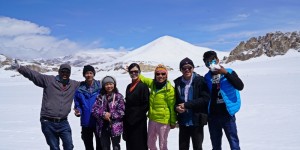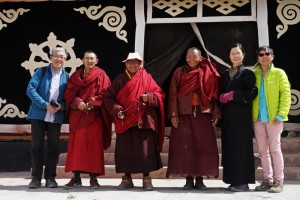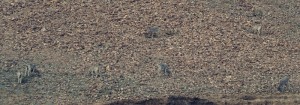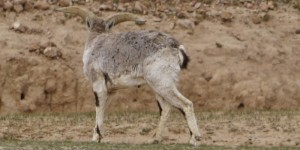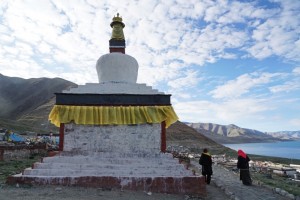15-day Circuit: Part 2 – Zanda – Lhasa: June 11 – 18, 2017
Day 8 Sunday: Zanda – Gar 噶尔(Shiquanhe 狮泉河) (270km)
We did not leave the hotel till 9:30am for Tholing Monastery, the oldest monastery founded by Yeshe-O, the second king of Guge Kingdom in 997 AD. The complex includes three temples: the Yeshe-O Temple (Gold House), the Lhakhang Karpo (White Chapel) and the Dukhang (all built by Rinchen Sangpo). There are many ancient precious and well-preserved frescoes.
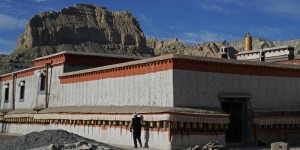 |
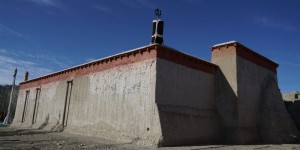 |
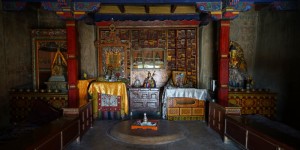 I visited this monastery in 2011 and did not mind revisiting it especially with a concessionary price (RMB 30). This time we could only see the Lhakhang Karpo which has a high ceiling with thin wooden pillars made of Deodar wood and is painted red. The floor is cobblestones while the ceiling is decorated in geometric designs. The restored frescoes are exquisite and beautiful. The painting of the ‘Money God’ is impressive.
I visited this monastery in 2011 and did not mind revisiting it especially with a concessionary price (RMB 30). This time we could only see the Lhakhang Karpo which has a high ceiling with thin wooden pillars made of Deodar wood and is painted red. The floor is cobblestones while the ceiling is decorated in geometric designs. The restored frescoes are exquisite and beautiful. The painting of the ‘Money God’ is impressive.
We were lucky to meet a 28-year-old monk who explained to us that the three treasures of the monastery, namely a 1000-year-old horn of a deer, an elephant tusk (which is available for public viewing once a year) and the stone foot print of Yeshi-O. The monk also took us to see the oldest part of the monastery – the room where Rinchen Sangpo spent years in translating the Buddhism scriptures.
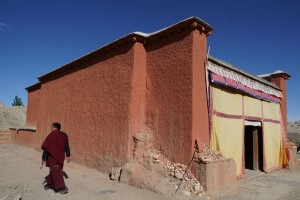 |
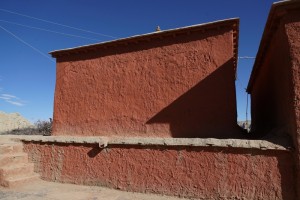 |
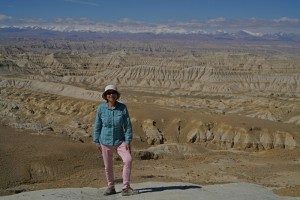 We left at 11:45am. As Zangbo had seemingly recovered, we decided to move on as quickly as possible. The road to Zanda is joined up with National Highway 219 at Namru那木如 where we had noodles (RMB20 a bowl).We followed the highway all the way to Gar (4500m) where we spent the two nights at the 4-star Ali Hotel (RMB480 for a double).
We left at 11:45am. As Zangbo had seemingly recovered, we decided to move on as quickly as possible. The road to Zanda is joined up with National Highway 219 at Namru那木如 where we had noodles (RMB20 a bowl).We followed the highway all the way to Gar (4500m) where we spent the two nights at the 4-star Ali Hotel (RMB480 for a double).
On the way to Gar, Bianba and I talked about having lamb/mutton in Xinjiang style for dinner. I took our two drivers and the group (except Brenda and Kylie who cannot stand the strong smell of mutton) for dinner. A most delicious meal for six with ten sticks of BBQ mutton cubes, a catty of hand-torn stewed mutton, a large plate of mutton in hot sauce and a large plate of noodles only cost RMB310. Excellent value!
Day 9 Monday: Gar – Pangong Lake班公错– Gar (260km)
We had a leisure day and did not start till 10am. We continued to drive along National Highway 219 and reached Rutog日土 (4250m)around 1pm.
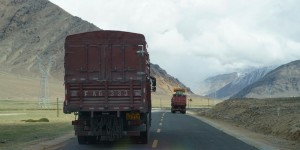 |
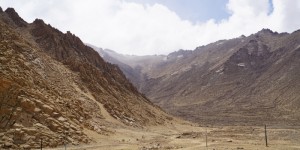 |
We had noodles again before heading to the Pangong Lake 班公错 (4350m), a saline lake measuring 134km with an area of 604km² at the Indo-China border. I was curious to see this lake as I was not permitted to visit it in 2013 when I was in Ladakh. The reason given was that ‘I am Chinese’.
We were taken to a holiday resort where we had an hour taking photos of the wetland and pigeons. The views from here are not particularly interesting. On the way back, we were lucky to see two black-necked cranes(Grus nigricollis). This beautiful bird breeds on the Tibetan Plateau and remote parts of India and Bhutan. We also saw a few types of waterfowls and birds in the wetland.
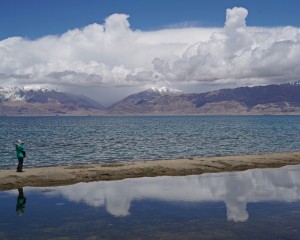 |
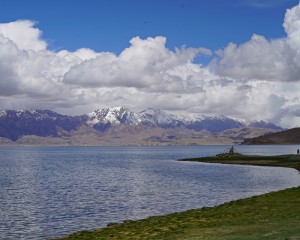 |
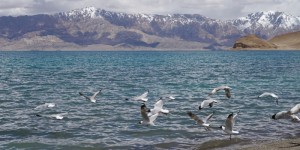 |
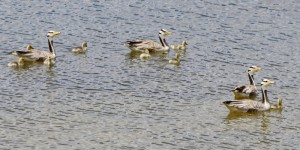 |
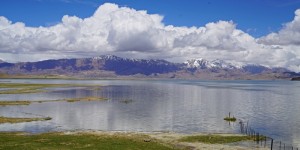 |
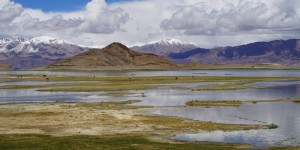 |
There are well-known prehistoric petroglyphs spreading over an area of 300km² near the far western town of Rutog. We had high expectations and were disappointed to see only a few rocks with carvings/paintings protected by iron bars on the roadside. The petroglyphs cover natural objects animals including tigers, sheep, wild boars and birds. Here are also other symbols including sun and moon, hunters and their tools namely spears and knives. We could identity more than a dozen on a few rocks.
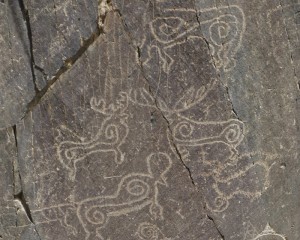 |
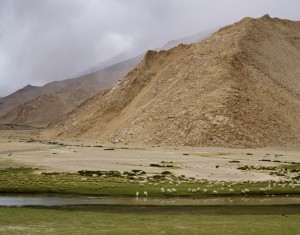 |
We were back in Gar around 6pm and had a panoramic view of the city from a pavilion above the city. Kai, SK, Winnie and I returned to the same Xinjiang restaurant. Kai insisted to treat the group. Thank you, Kai!
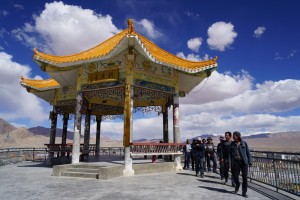 |
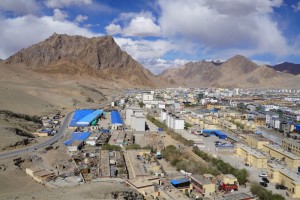 |
Day 10 Tuesday: Gar – Gerze 改則 (500km)
Today, we turned east taking the National Highway 301 (also known as ‘Ngari northern route’ 阿里大北線). This’s the first time I travelled in this remote part of Xizang. Lhasa is about 1760km away. Today we went over several passes between 4800 and 5000m. We saw very few cars on the road and passed a few scattered settlements.
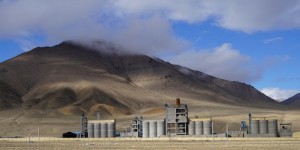 |
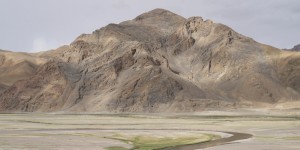 |
After driving some 70km, we suddenly found ourselves in a white world of snow. According to Bianba, this stretch of land is often covered in snow in June. But the snow goes before late June. We were thrilled and could not stop taking photos!
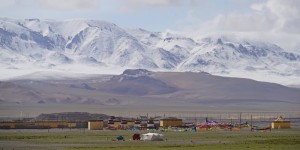 |
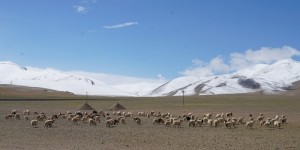 |
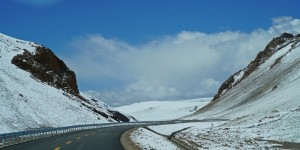 |
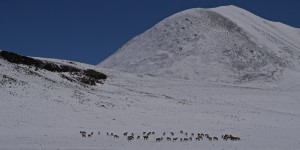 |
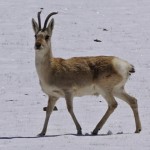 |
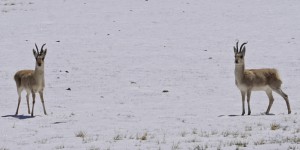 |
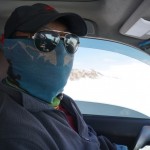 |
We had a pretty but uneventful drive. Himalayas is no longer in sight. Occasionally, we saw some wild donkeys.
We stopped next to a salt lake for lunch. It’s a long drive and we finally reached Gerze (4416m) hungry and tired. The town looks rustic and our hotel is basic (RMB280 for a double). We found a decent restaurant right next to the hotel and had a good dinner! What a nice surprise! We strolled around the main street looking at the shops selling clothing and daily goods. We were surprised to find a robe made with sheep skin costing RMB3000! We went to several ‘supermarkets’ which are essentially small convenient stalls. These stalls and restaurants are often owned by Han Chinese coming from nearby provinces particularly Sichuan and Chongqing. They normally stay in Xizang from April to November and spend the winter with their family back home.
Day 11 Wednesday: Gerze – Wenbu South Village文布南村(400km)
As there are not many places open for breakfast before 9am, we bought fruits and instant noodles for breakfast.We set off again at 9am. Once outside Gerze, we began driving on bumpy dirt road or partially paved road for the next three days. Hundreds of workers are working feverishly under harsh condition. I only hope they are reasonably paid for their hard labour! I expect National 301 be fully paved in the next two years.
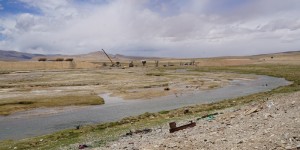 |
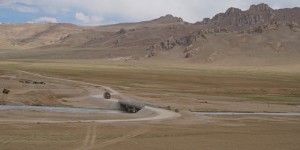 |
We stopped at Asog 阿索 village for lunch and realised we were already in the Nagqu prefecture. At 2:30pm, we set off again and turned south heading to our next destination – Wenbu village. We had a wonderful drive with stunning landscape and wildlife. Here we saw the third type of Tibetan sheep –Rock Antelope 大岩羊 which stay around rocky terrains. We watched the group of nine for over ten minutes. In addition, we also saw the treasured Tibetan antelopes and the common ones from the plateau 大原羊.
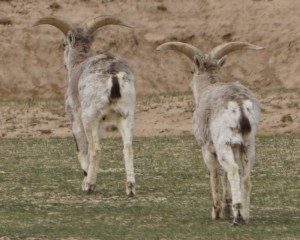 |
|
We had a scenic ride inter pierced with snow, sunshine, sleet and hails. By the time we reached a landmark – a gigantic rock formation in the form of a ‘Fist”, we stopped for photos.
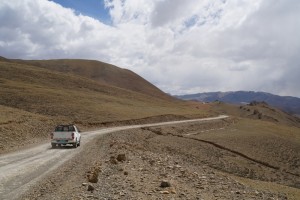 |
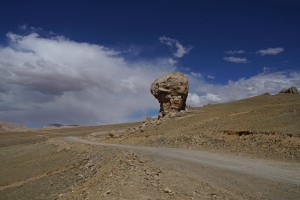 |
Around 5pm, we had the first glimpse of the Tangra Qonco 當雄錯(4475m) with an area of 54.5 km² by Wenbu North Village文布北村. The beautiful reflection of the mountain range surrounding the lake which has a striking turquoise rim are picturesque. The village is quite large with an impressive monastery. Bianba said we would visit it the following day.
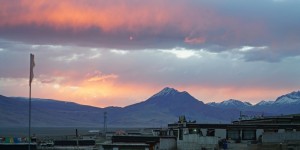 We drove for almost another hour before arriving at the Wenbu South Village 文布南村next to the Tangra Yumtso 當惹雍錯(4600m) the largest holy lake for Bon religion followers. At a family guesthouse, we met a couple from Beijing who has been travelling in Xizang thrice. We paid RMB100 for a bed and had to use communal toilet not too far from the house. As the room reserved for us was not good, Kylie and Brenda decided to take the room on the upper floor with eight beds. Kylie kindly paid RMB140 for the extra two beds. Thank you Kylie. We all slept fairly well except Kylie who only managed to sleep before sunrise! Before dinner, I walked to the lake shore where I could see the Dargo Mountain達果雪山(Holy Mountain) at the furthest end of the holy lake.
We drove for almost another hour before arriving at the Wenbu South Village 文布南村next to the Tangra Yumtso 當惹雍錯(4600m) the largest holy lake for Bon religion followers. At a family guesthouse, we met a couple from Beijing who has been travelling in Xizang thrice. We paid RMB100 for a bed and had to use communal toilet not too far from the house. As the room reserved for us was not good, Kylie and Brenda decided to take the room on the upper floor with eight beds. Kylie kindly paid RMB140 for the extra two beds. Thank you Kylie. We all slept fairly well except Kylie who only managed to sleep before sunrise! Before dinner, I walked to the lake shore where I could see the Dargo Mountain達果雪山(Holy Mountain) at the furthest end of the holy lake.
We had ordered a leg of lamb for RMB220. But it was a disappointment: there was not much meat and it was not well cooked. The chef also prepared us five vegetable dishes. As a result, we paid some RMB400 for the meal. Not value for money at all!
Day 12 Thursday: Wenbu South Village – Nyima 尼瑪 (200km)
I woke up when Brenda called out ‘7 o’clock’! I quickly got dressed, went to the public open-air toilet and brushed my teeth before taking a morning walk with Kai, SK and Winnie. Kylie was talking with the Beijing guy about photography.
I had one of the best morning walks. Four of us headed to the eight stupas and praying flags at the back of the village. Air was fresh and it’s quiet. The locals were walking counter-clockwise (the tradition of Bon followers). Their sign is also different. I also saw some ‘tsatsa’ laid on the ground. It’s atmospheric!
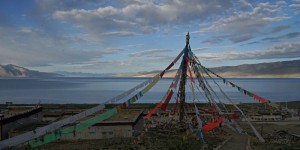 |
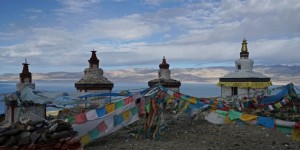 |
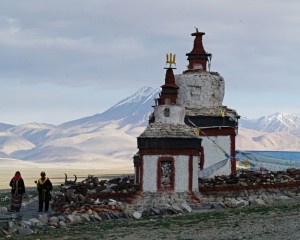 |
I saw a small monastery across the river. I suspect it belongs to the Bon religion. I love to see it but it is too far to go. Then I watched a large group of primary students jogging through the village with their PE teacher. Some local women were busy attending to their sheep. Busy but peaceful and calm.
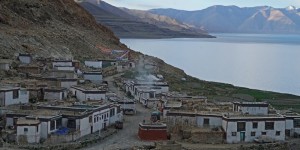 |
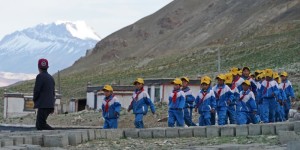 |
After breakfast, we set off before 9:30am and were soon back in Wenbu North Village.
We arrived at the monastery 當雄寺 belonging to Nyingma School 寧瑪派 with some 20 monks. We entered while they were having their morning chanting and praying session. Brenda, Kai and I stayed quietly for half an hour looking at the setting, layout, images, statutes and paintings. The hall though small is serene, atmospheric and well-preserved. When we came out, we explored other parts of the monastery which is under restoration. In the courtyard, we saw the monks coming out and took a photo with the Head Monk 丹增.
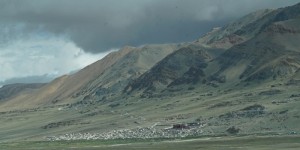 |
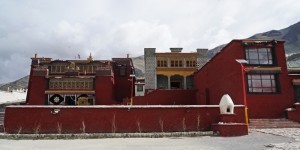 |
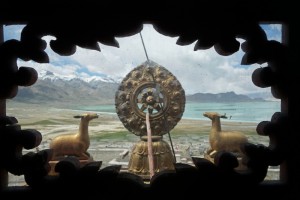 |
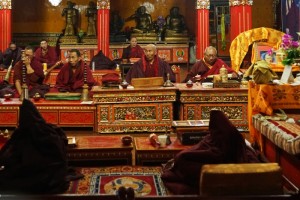 |
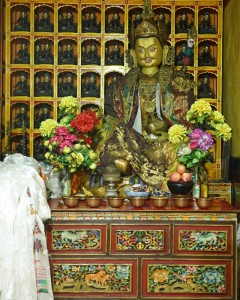 |
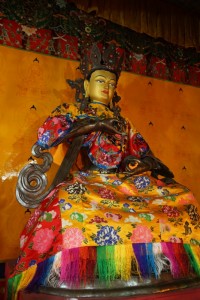 |
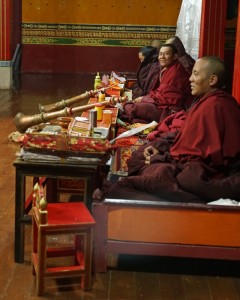 |
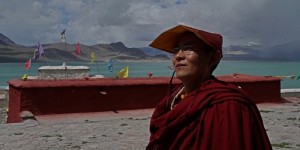 |
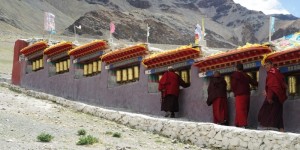 |
We left the village around noon. Today, we had a short and uneventful drive with few animal sighting. We were driving mostly on dirt road and soon arrived in Nyima, another new and fast growing town along National Highway 301.
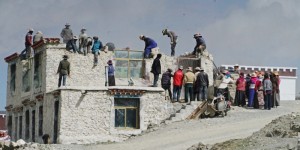 |
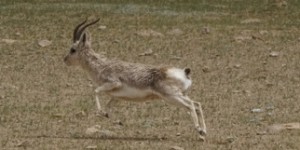 |
We stayed at the best and newest hotel (RMB 280 for a double). The town looks uninviting and I did not go out at all. We had noodles in a simple eatery outside the hotel in the afternoon and dinner in the hotel (RMB140 and 200 for six respectively). Once again, we had a long interesting chat with the owner of the restaurant who came from Sichuan.
Day 13 Friday: Nyima – Bangoin班戈 (350km)
After having steam bun and congee for breakfast, we set off at 8:30am. We were on dirt road for 180km before getting back on paved road for the rest of the journey to Bangoin.
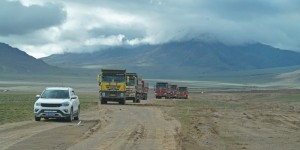 |
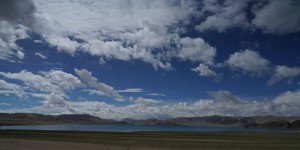 |
Today’s highlights are LAKES: we passed five lakes. But the weather was funny: raining, cloudy with occasional sunshine. As a result of the weather, I found three lakes particularly enchanting owing to its colours, shape or shade created by the ever-changing sunlight including Silingtso 色林錯(4500m) – the second largest lake in Xizang with an area of 1865km².
We stopped by Silingtso for lunch. It started to rain when we were ready to move on. I had a self-cooked rice box for lunch. Unlike instant noodles where one needs to pour in hot water, this rice box can heat up on its own! It’s a convenient way to have a hot meal outdoor and can be a great success cross the world one day!
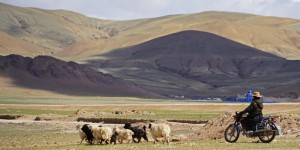 |
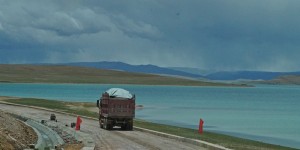 |
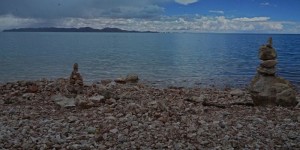 |
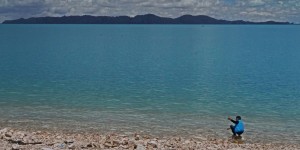 |
At 5:30pm, we arrived at a hotel in Bangoin (4900m), another fast growing town along the highway. We paid RMB380 for a double which is awful: the swat toilet is smelly! The worst value-for-money accommodation we had on this trip.
Day 14 Saturday: Bangoin – Namtso 纳木错(230km)
We found an eatery selling soya milk and buns that opened at 8am. The owner is a young guy in his 30s who came from Henan. He is by himself working over 18 hours a day. He is selling his business as he wants to return to his hometown to welcome his second baby in a few months’ time. These are all stories I would not forget: people coming to work in Tibet are tough and most hard-working who can stand the harsh condition. I wish them good luck and are rewarded for their hard work.
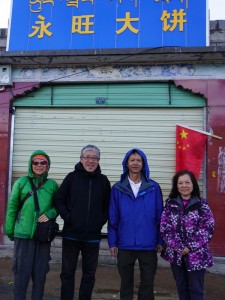 |
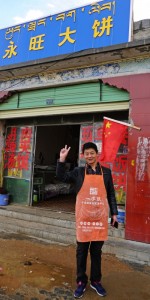 |
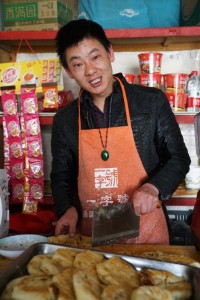 |
We set off at 9am. But one of the tyres had a hole and we spent half an hour fixing it. The man did a good job and Bianba told us he paid RMB40 for the job done. Unbelievably cheap! We had a smooth short drive to Namtso with a stop at Bangmotso 班莫錯, a beautiful lake with most wonderful blue colours (reflections from the blue sky and morning lights).
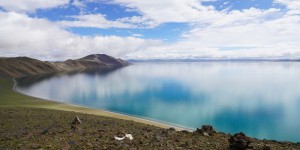 |
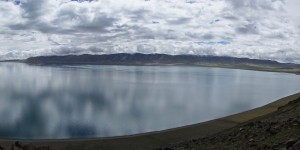 |
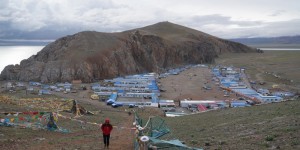 About 30km from Namtso, we said goodbye to our Beijing friends who would go to the other end of the lake for the night. About 2pm, we arrived in Namtso (4700m) where we paid a reduced entrance fee of RMB60. We stayed in a large guesthouse and paid RMB 280 for a double without facility. The worst thing is that all have to use communal toilets which are unbearable smelly and dirty. In this respect, I do not think this scenic area has improved since my last visit in 2011.
About 30km from Namtso, we said goodbye to our Beijing friends who would go to the other end of the lake for the night. About 2pm, we arrived in Namtso (4700m) where we paid a reduced entrance fee of RMB60. We stayed in a large guesthouse and paid RMB 280 for a double without facility. The worst thing is that all have to use communal toilets which are unbearable smelly and dirty. In this respect, I do not think this scenic area has improved since my last visit in 2011.
After lunch and a short rest, all except Brenda joined me on a hike. First, we went up the hill behind the hotel for over an hour. We found a lot of rock carvings and paintings at the bottom of the hill. They are more interesting than those in Rutog.
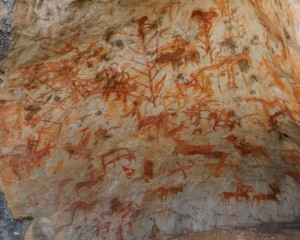 |
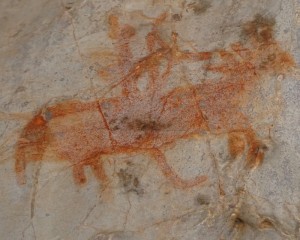 |
Then we followed the trail around the peninsula with lots to see. Kai walked in the front. SK, Winnie and I walked together in the middle. But we soon lost sight of Kylie. We had an enjoyable walk till 8pm visiting two monasteries and a nunnery.
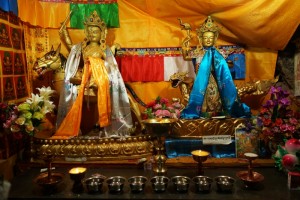 |
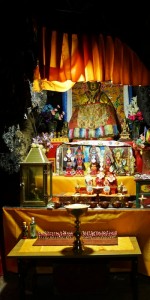 |
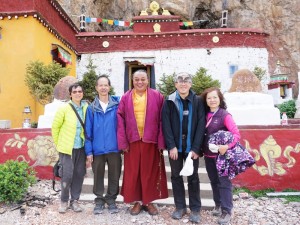 |
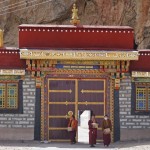 |
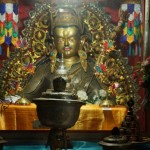 |
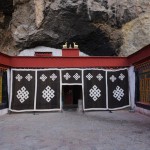 |
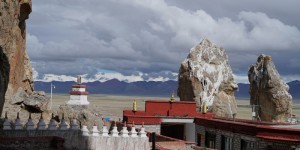 |
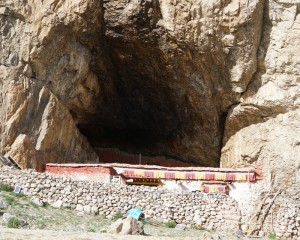 |
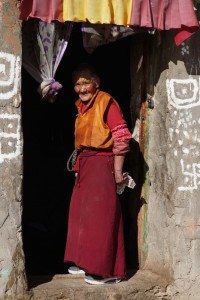 |
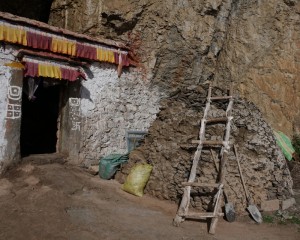 |
There are many rocks with all sorts of names and in various shapes. We found a few caves with lots of carvings and paintings. Kai also discovered fossils of coral along the road.
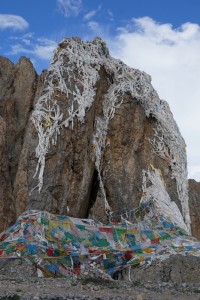 |
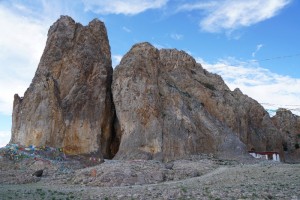 |
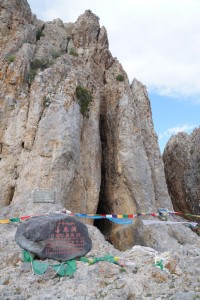 |
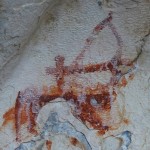 |
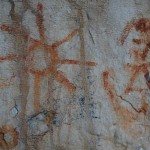 |
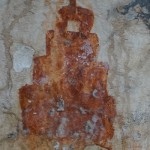 |
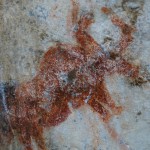 |
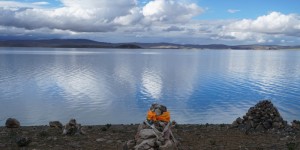 |
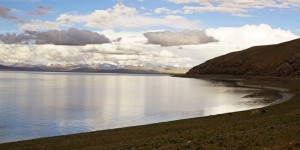 |
We found a nice Sichuan restaurant and had a great meal with hand-torn mutton and vegetables for RMB225 for four. Not bad for its quality! It rained heavily the whole night.
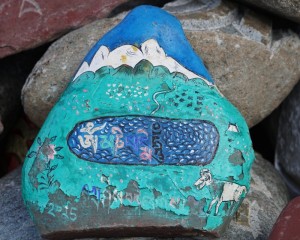 |
 |
Day 15 Sunday: Namtso – Lhasa (230km)
We planned to watch sunrise. I got up at 6am and looked outside. The sky was grey and I was not optimistic about sunrise. Anyway, Kylie, SK, Winnie and I decided to take a morning walk. We sat off before 6:30am, walking slowly up the well-trodden path to the top which is a favourite spot for sunrise and sunset. Though there was no sunrise, I enjoyed the walk just the same.
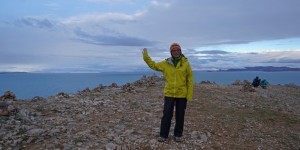 |
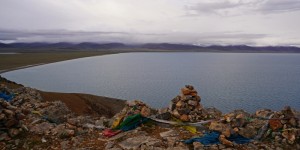 |
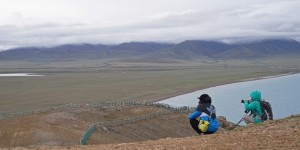 |
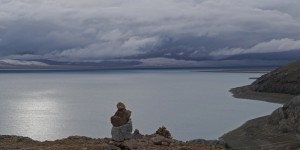 |
After a nice breakfast in the same Sichuan Restaurant, we set off around 9:45am. On the way, Bianba pointed out how locals dig up caterpillar grass 蟲草 from mountainside between 3000 and 4500m. What a tough and labourious job! (Our 4×4 went over the pass and drove through the valley. We saw dozens of locals searching for the precious grass on the steep slopes)
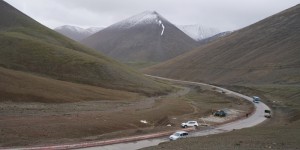 |
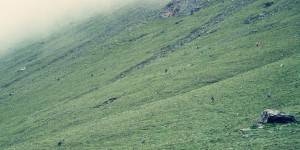 |
We had a shopping stop in Damshung當雄. I bought a lot of yak products as souvenir. The shop provides a free lunch for visitors. The next stop was at the monument of NyainqentangihaShan 念青唐古拉山 with its peak stands at 7162m.
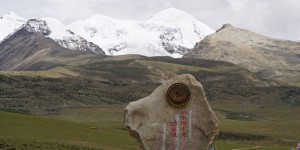 |
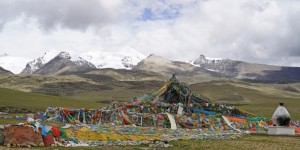 |
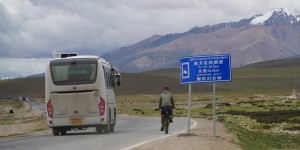 |
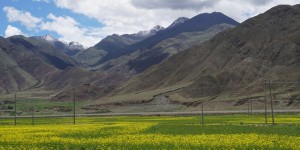 |
We finally reached Lhasa after 4pm and spent the next two night at the Lhasa Hotel (RMB400 for a double). In a way it’s a relief to be back in good shape (given our age) completing a 3770-km journey in 15 days. We went out for a hot-pot dinner (RMB327).
End of the 15-day the West & North Circuit Trip in Xizang


